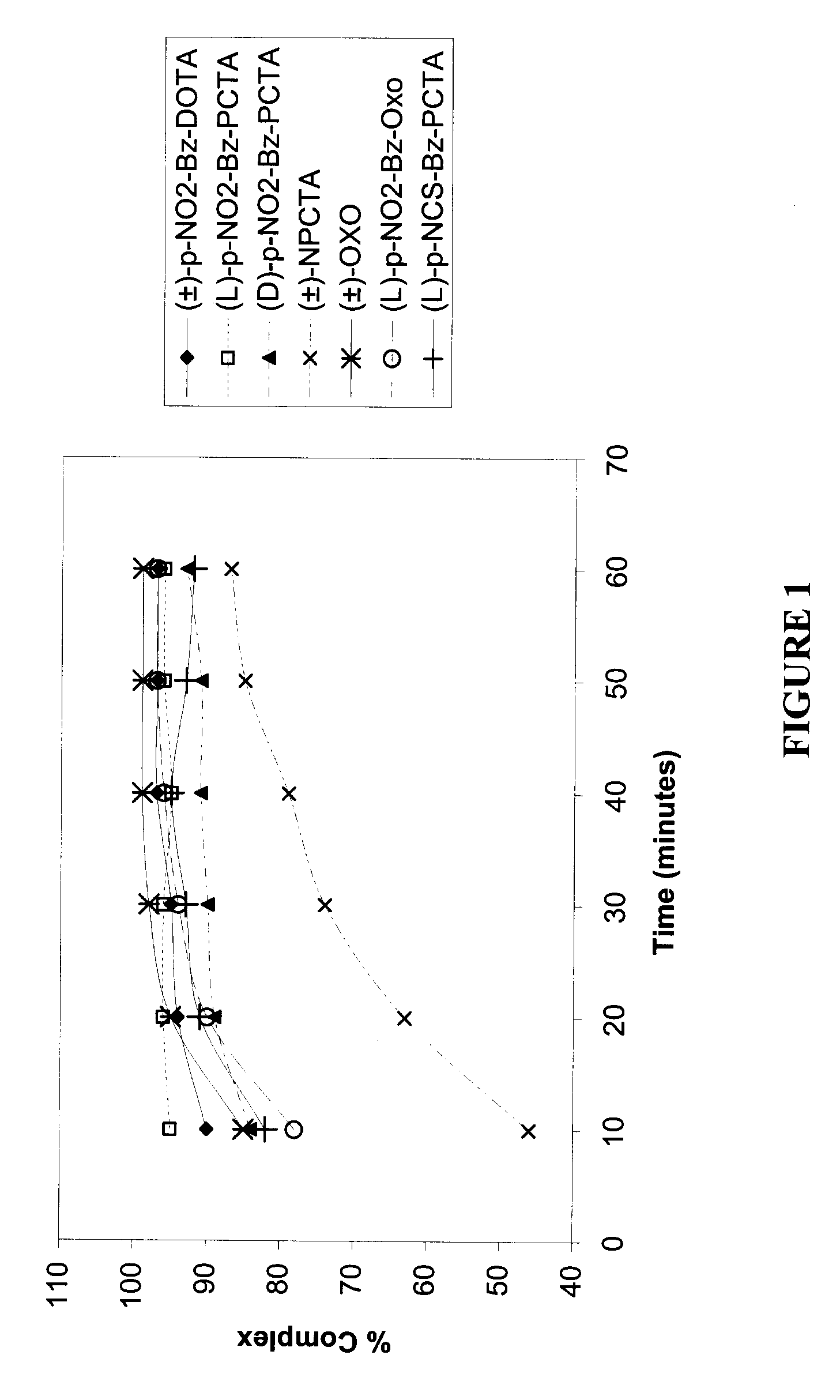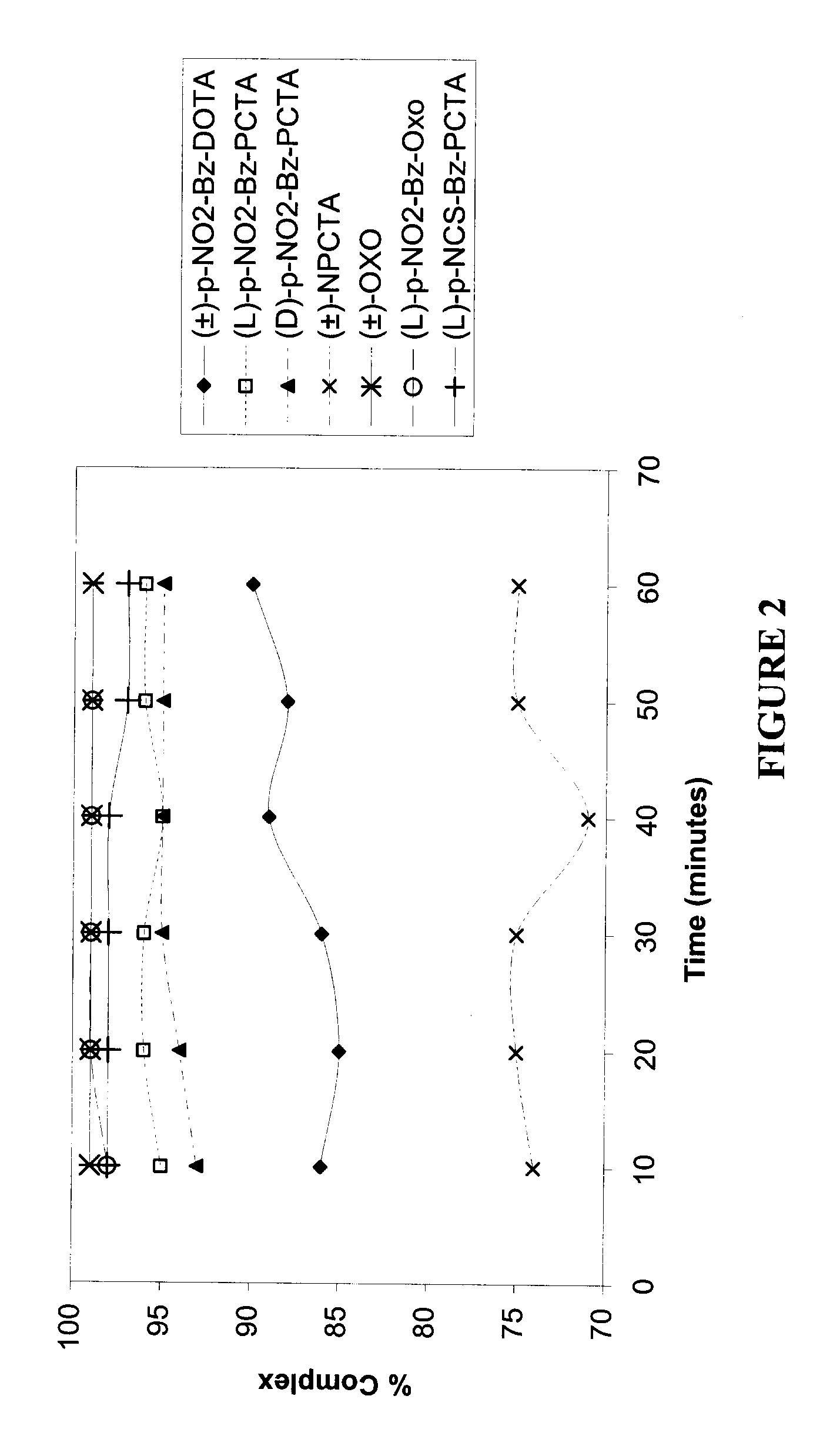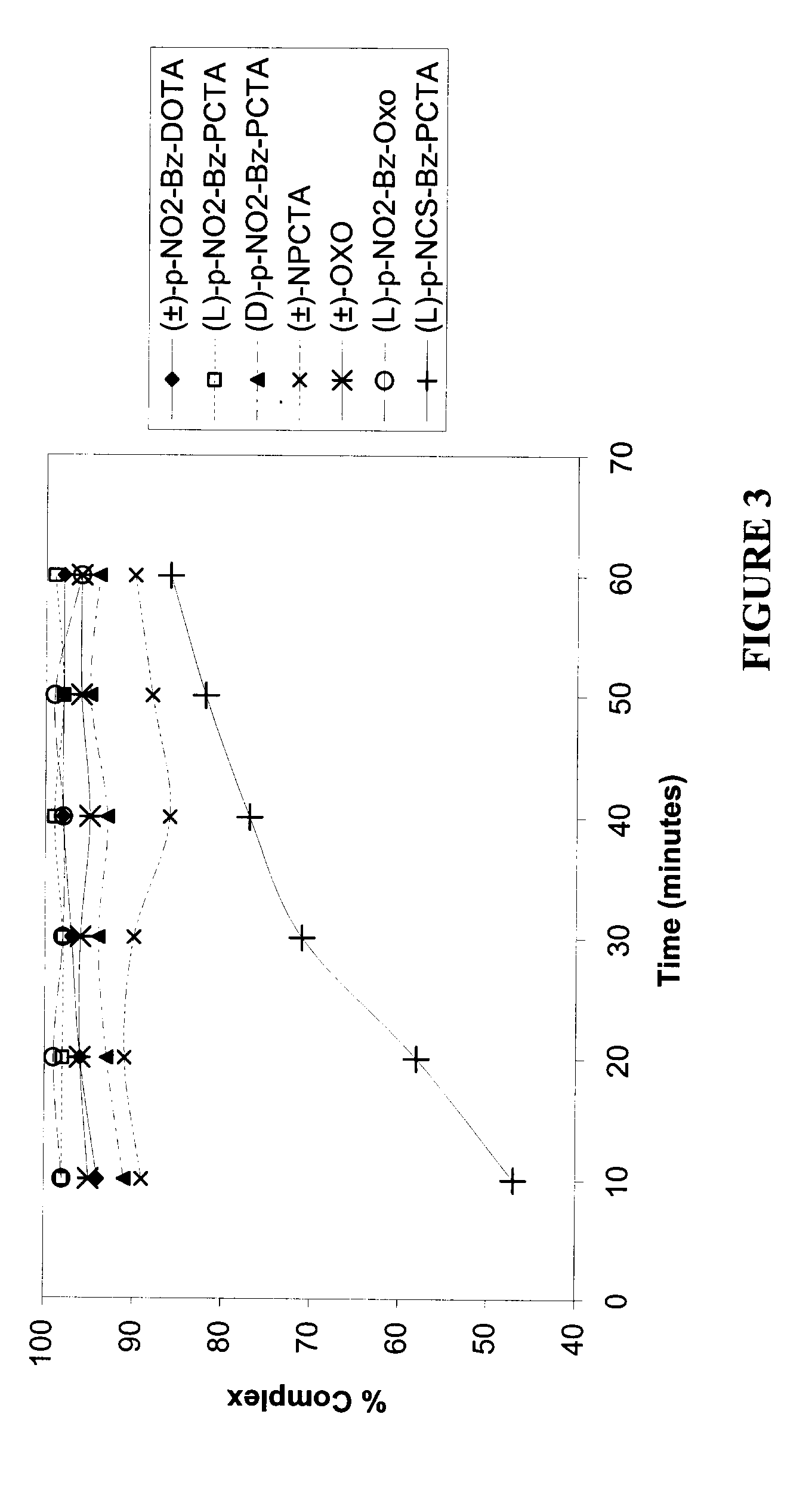Bifunctional Polyazamacrocyclic Chelating Agents
a chelating agent and polyazamacrocyclic technology, applied in the field of bifunctional polyazamacrocyclic chelating agents, can solve the problems of slow kinetics of complexation, additional energy input, and long reaction time of ligand systems, and achieve the effect of improving complexation kinetics and reducing the stability of ions complexes
- Summary
- Abstract
- Description
- Claims
- Application Information
AI Technical Summary
Benefits of technology
Problems solved by technology
Method used
Image
Examples
example 1
Kinetics of Complexation of Polyazamacrocyclic Ligand with Metal Ion
A) Complexation Studies Involving 90Y3+
[0138]The fastest initial rate of complexation was observed with (L)-p-NO2-Bz-PCTA (95% complexation after 10 minutes), followed successively by (±)-p-NO2-Bz-DOTA, (±)-OXO, (D)-p-NO2-Bz-PCTA, (L)-p-NCS-Bz-PCTA, (L)-p-NO2-Bz-OXO and (±)-NPCTA. For (±)-p-NO2-Bz-DOTA, (±)-OXO and (L)-p-NO2-Bz-OXO, values of percent complexation above 95% were achieved after 30 minutes. In general, the highest percent complexation of metal ion was observed with the ligands (L)-p-NO2-Bz-PCTA, (±)-p-NO2-Bz-DOTA, (±)-OXO and (L)-p-NO2-Bz-OXO.
[0139]The relatively slower kinetics of complexation associated with (±)-NPCTA may be attributed to a steric or electronic effect associated with the position of the pendant linker p-NO2-Bz group on the macrocyclic ring.
B) Complexation Studies Involving 111In3+
[0140]The fastest initial rate of complexation was observed with (±)-OXO, (L)-p-NO2-Bz-OXO and (L)-NCS-Bz...
example 2
Effect of [Ligand] / [Metal Ion] on the Percent Complexation of the Ligand
A) Effect of [Ligand] / [90Y3+] on the Percent Complexation of the Ligand
[0146]A value of percent complexation of above 95% was achieved with (±)-p-NO2-Bz-DOTA and (L)-p-NO2-Bz-PCTA at a molar ratio of ligand / 90Y3+ of 2:1. With (D)-p-NO2-Bz-PCTA, ˜95% complexation was achieved at a molar ratio of ligand / 90Y3+ of 10:1. For (±)-OXO and (L)-p-NO2-Bz-PCTA, a value of above 95% complexation was obtained at the molar ratio of ligand / 90Y3+ of 5:1 or above. A value of 90% complexation was not achieved with (±)-NPCTA even at values of molar ratio of ligand / 90Y3+ of greater than 20:1.
B) Effect of [Ligand] / [111In3+] on the Percent Complexation of the Ligand
[0147]A value of percent complexation of above 95% was achieved with (L)-p-NO2-Bz-PCTA and with (L)-p-NO2-Bz-OXO, at a molar ratio of ligand / 111In3+ of 2:1. With (D)-p-NO2-Bz-PCTA, ˜95% complexation was achieved at a molar ratio of ligand / 111In3+ of 10:1. With (±)-p-NO2-Bz...
example 3
Stability Studies
[0149]FIGS. 7-9 illustrate the stability of (±)-p-NO2-Bz-DOTA-metal ion complex and a (L)-p-NO2-Bz-PCTA-metal ion complex in serum, or 0.1 M Glycine buffer (pH=2, 4 or 6) as a function of time, where the metal ion is 90Y3+, 111In3+ or 177Lu3+.
[0150](L)-p-NO2-Bz-PCTA-90Y3+ complex was relatively more stable than the (±)-p-NO2-Bz-DOTA-90Y3+ complex in serum. The stability of the two complexes were similar in Glycine buffer, pH 2, 4 or 5.
[0151]Both the (L)-p-NO2-Bz-PCTA-111In3+ complex and the (±)-p-NO2-Bz-DOTA-111In3+ complex were similarly stable in 0.1 M Glycine buffer, pH 2, 4 or 5. The (L)-p-NO2-Bz-PCTA-111In3+ complex was relatively more stable than the (±)-p-NO2-Bz-DOTA-111In3+ complex in serum over time.
[0152]Both the (L)-p-NO2-Bz-PCTA-177Lu3+ complex and the (±)-p-NO2-Bz-DOTA-177Lu3+ complex were relatively less stable in serum compared to 0.1 M Glycine buffer, pH 2, 4 or 5. The (±)-p-NO2-Bz-DOTA-177Lu3+ complex was relatively more stable than the (L)-p-NO2-Bz...
PUM
| Property | Measurement | Unit |
|---|---|---|
| pH | aaaaa | aaaaa |
| pH | aaaaa | aaaaa |
| pH | aaaaa | aaaaa |
Abstract
Description
Claims
Application Information
 Login to View More
Login to View More - R&D
- Intellectual Property
- Life Sciences
- Materials
- Tech Scout
- Unparalleled Data Quality
- Higher Quality Content
- 60% Fewer Hallucinations
Browse by: Latest US Patents, China's latest patents, Technical Efficacy Thesaurus, Application Domain, Technology Topic, Popular Technical Reports.
© 2025 PatSnap. All rights reserved.Legal|Privacy policy|Modern Slavery Act Transparency Statement|Sitemap|About US| Contact US: help@patsnap.com



